|
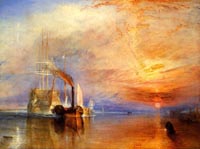
|
Perhaps
one of the most famous steam paddle tugs in history was the
'Monarch', depicted in JMW Turner's painting 'The Fighting Temeraire',
first exhibited at The Royal Academy in 1839.
|
|
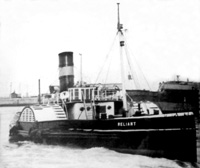
|
The
last-but-one steam paddle tug in the UK, 'Reliant', launched 1907,
was controversially scrapped after being on display in the Neptune
Hall at the National Maritime Museum, Greenwich. Only one engine
and half a paddle wheel remain at Greenwich. The steering engine
and chains have been preserved at the Markham Grange Steam
Museum, Brodsworth. |
|
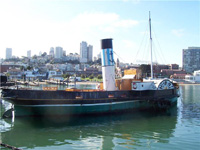
|
It
is thought that the only other British built paddle tug in the
world is the 'Eppleton Hall', launched 1914, currently berthed
at the Hyde Street Pier,
San Francisco. |
|
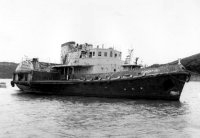
|
Some
diesel-electric paddle tugs were built latterly for the Royal
Navy, but the last one, 'Forceful', was scrapped after being used
as a missile target. |
|
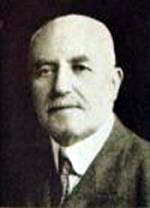
John Hetherington Amos
|
History
of the John H. Amos
The
John H. Amos was the last paddle tug built in Great Britain
for civilian owners. The initial design for the vessel was said
to have been draughted in 1888, and when she appeared in 1931
she was something of an anachronism.
The
tug was built for the Tees Conservancy Commissioners in a Clyde
shipyard by Bow McLachlan & Co Ltd. of Paisley, Scotland,
and named to honour an octogenarian Secretary to the Commissioners,
John Hetherington Amos who
died in 1934.
|
|
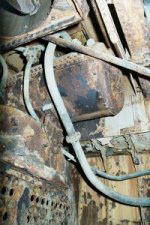
Extra steam container
|
Before
completion of the vessel, Bow McLachlan & Co. Ltd. were
declared bankrupt. The liquidators finished the work by using
materials that were already available in the yard. As a result
some aspects of the vessel were better than the original specification.
Unfortunately other components turned out to be unsuitable.
It
was soon discovered that the boilers they used could not supply
enough steam for the large diagonal compound engines. A maximum
of only 11 knots was achieved instead of the intended 13 knots.
Among
other modifications that were made was an extra steam container
added to each boiler. This may have had the effect of supplying
"drier" steam, but would not necessarily have solved the problem
of providing more steam.
|
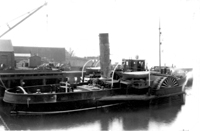 |
The
tug was completed in February 1931 but the Tees Conservancy Commissioners
would not accept her due to the speed not being up to specification.
It was to be two years before she was formally accepted. |
|
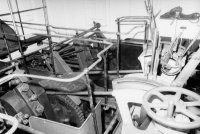
View
of the engine room
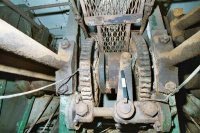
Clutch
and turning gear
|
The hull was constructed from riveted steel plate and some other
details are as follows: -
Official
Number : 160734
Yard Number : 497
Previous Port of Registry : Middlesbrough
Present Port of Registry : London
Length : 110 feet
Breadth : 22.5 feet
Moulded Depth : 11.5 feet
Overall Width (paddle to paddle) 43 feet
Gross Tonnage : 202 tons
Actual Weight, approx. : 300 tons
Registered Tonnage : nil
Two compound diagonal engines with Bremme valve gear
Nominal Horsepower : 126
Indicated Horsepower : 500
Length of Stroke : 44 inches
Diameter of H.P. Cylinders : 17¼ inches
Diameter of L.P. Cylinders : 34½ inches
Engines can be worked separately or joined by a dog clutch.
Boilers : Two coal fired twin furnace Scotch type
Working Pressure : 125 p.s.i.
The
estimated cost, delivered complete, was believed to be £18,500
but it cost less than the estimated price because of the
problems with specification.
Please
click here for the General
Arrangement Plan
|
|
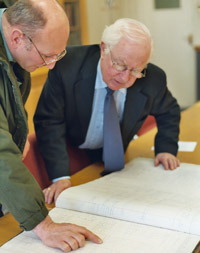
|
Working
Life 1931 to 1967
During
research done by Martin Stevens and Chris Jones in February
2004 in connection with the HLF Project Planning Grant, many
of the myths relating to the John H Amos were laid to rest.
It had been understood that she was a failure as a tug. This
is not true.
For
27 years between 1940 and 1967, the period covered by the Daily
Towage Records at Teesside Archives, she worked an almost monotonous
daily routine doing exactly the work she was built for. She
took barges to dredgers and the dumping grounds, towed the dredgers
as they had no propulsion of their own, and transferred the
crews.
|
|

|
This
was confirmed by the last Chief Engineer of the John H Amos,
Ron Young.
Ron
told of minor problems such as the Sissons generator being difficult
to regulate. The only shortcoming concerning the boilers was
the reluctance of the management to provide a second stoker.
This meant that one man had to stoke four furnaces during a
full day's work all by himself.
|
|
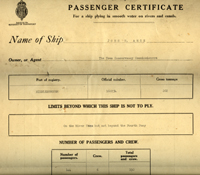
|
Ironically
the story of the tug's difficulties during building did in fact
give it an advantage. It seems that the John H Amos was not
expected to be a success, so she was given a certificate for
144 passengers to make her more useful.
She
was said to have been used to take the Tees Commissioners and
their official guests on excursions. After careful study of
the ship's log, a few cryptic entries were found when a very
odd excursion took place.
|
|

|
There
was a long wooden structure in the mouth of the River Tees known
as the Fifth Buoy Light with a light at each end. When approaching
ships had the two lights in line they knew they were on the right
course. In the middle of this structure was a building described
as a dancehall or café. This could only be reached by boat, and
belonged to the Tees Commissioners. Perhaps it is best left to
the imagination as to why the Commissioners felt this was the
place where they would spend their leisure time. |
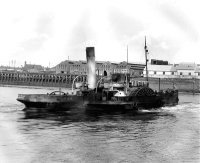 |
Ron
Young told of an incident in 1959 when the vessel was arrested
for smuggling. She was involved in towing barges to ships anchored
offshore and illicit trading in alcohol was taking place. There
is no mention of this incident in the ship's log, although it
is noted that the skipper changed for a while during the critical
period.
Although
the case was taken to court, nobody was disciplined or sacked.
According to Ron this source of alcohol was common practise
and a widely used perk.
|
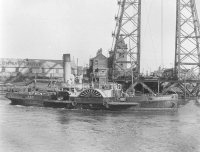 |
Ron
told us about races between the paddle tug John H Amos and a
TID tug named Lackenby (ex TID 182) in the same fleet. The paddle
tug always won.
The last skipper of the John H.Amos, Archie Taylor, had told
of his four years experience with the tug. "We used to tow barges
to the dredgers, then we would take the superintendent round
and then pick up the men again, and take water to ships that
needed it."
"She
was good, but was a bit hard on the steering." (no steam steering
engine)
"The man feeding the boilers had to work hard to keep up steam.
We would get through about three tons of coal in a full eight
hour day."
When
towing barges, they were always lashed alongside. In this configuration
it was normal to use only one paddle. With the width of the
barge added to the 43 feet of the tug this would have been a
significant obstacle to meet in the narrower reaches of the
Tees.
|
|
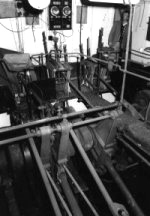
|
Ron
confirmed the archive entries that the tug operated with the
following crew: - Skipper,
Mate, Two engineers, Fireman and Ships Boy (known as 6th hand)
One engineer was responsible for the port engine and the other
for the starboard engine.
The
Tees has been referred to disparagingly as a muddy ditch. The
raison d'être of the John H Amos was to be a key part of the
continuous dredging team. Her relatively shallow draught compared
with a propeller driven screw tug enabled her to work in the
shallow waters as far up river as Stockton.
|
|
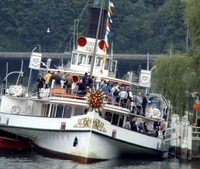
A
listing Swiss paddle boat DS Unterwalden
|
Unlike
all passenger carrying paddle steamers, the John H. Amos was able
to work each engine independently. This gave the manoeuvrability
necessary for a tug. It was found that on passenger vessels, when
approaching port, the passengers went to one side of the boat
to disembark. If the engines were then worked independently the
uneven distribution of weight could capsize the vessel. The John
H Amos invariably worked with the clutch disengaged. |
|
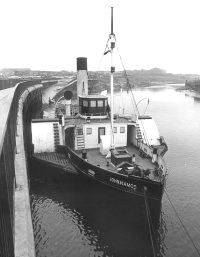
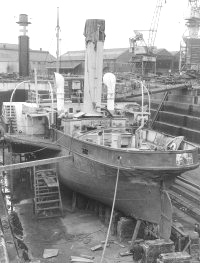
|
1967
to 1976
The
John H. Amos was withdrawn from service in 1967, and two years
later was presented by the Tees and Hartlepool Ports Authority
to the County Borough of Teesside for "The People of Cleveland"
.
In
December 1971 she was moved from Middlesbrough to Stockton Corporation
Quay. A team of eight young people working under the Community
Industrial Scheme, organised by the Youth Employment Service
were part of a plan to convert the tug into a floating museum.
In
1973 when Martin Stevens and Michael List Brain from the Medway
Maritime Museum visited the vessel in Stockton there was supervised
work in progress, mainly concerned with the bilges and the interior
of the hull.
In
June 1973, the John H. Amos was dry docked. It is said that
£19,000 was spent on replating part of the hull. This was done
by welding the new plates and not by traditional riveting. The
work was done at Smiths Dock, Middlesborough.
|
|
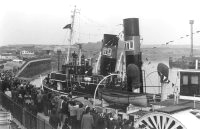
|
1976
to 2001
When
the government of the day re-organised local councils the Youth
Training Scheme was discontinued by the new council. This left
them in an embarrassing position of having spent rate-payers
money on a "white elephant" which was now destined for the scrap
yard.
Martin
Stevens and Michael List Brain heard of the predicament and
negotiated to buy the John H. Amos for £3,500 thus allowing
the council to save face.
During
February 1976 Martin Stevens on the steam tug Cervia had towed
four trawlers from Grimsby to Blyth in Northumberland for scrap.
(They were Northern Prince, Northern Sea, Northern Sun, and
Northern Chief). He then diverted to Stockton to collect the
John H.Amos.
|
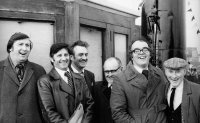 |
There
was controversy among local politicians right up to the point
of hand over.
Cleveland County Archives Department refused to release papers
relating to the vessel. Councillor Tony Ellwood is quoted as
saying that the incident was the "last straw in a bloody-minded
attitude adopted by the County towards Stockton." The Archives
Department agreed to release the documents only half an hour
before the John H.Amos was due to depart.
Stockton's
Mayor, Councillor Norman Duff, headed a civic party on the bridge
of the John H.Amos to accept a cheque and perform a re-naming
ceremony by breaking a bottle of champagne on the deck.
|
|
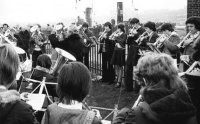
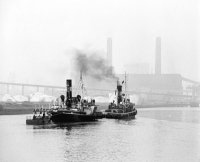
|
Watched
by a crowd of 400, and to the accompaniment of "Rule Britannia"
played by a local brass band, the strangely "time-warped" tow
set of down the Tees late in the afternoon of March 4th 1976.
For
a while the tug was re-named Hero, and was owned and managed
by a company called ITL International Towing Ltd. These name
changes were part of a strategy employed by the Medway Maritime
Museum to give confidence to customers who may have had doubts
about a Museum tug being used to tow their vessels.
It
was known from the outset that the John H.Amos was in a different
league to the other three working tugs. The policy of the Museum
was that the best way to preserve vessels was to work them.
But they acquired the John H.Amos knowing that the most they
could do was to prevent her from being scrapped because of the
enormous costs involved in total restoration.
|
|
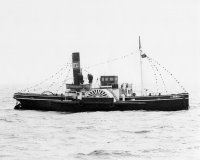
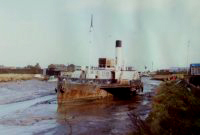
|
Later
in 1976 the Medway Maritime Museum fleet was divided and Martin
Stevens took on responsibility for the steam tug T.I.D. 164
and the John H.Amos.
When
Lloyds Insurance bought Gun Wharf, Chatham, the John H.Amos
was no longer welcome and was moved to Milton Creek and then
Faversham Creek, towed by T.I.D. 164.
A paddle tug is not the easiest vessel to find a home for. In
the South East of England there are many tidal mud berths where
working vessels can sit on the mud at the edge of a river or
creek when the tide goes out. A paddle tug cannot use such a
berth because, where a conventional vessel would normally sit,
she has a paddle. The hull would sit on the slope to the centre
of the creek or river.
Every
time the tide went out the tug slithered to the centre of the
creek. A local tug had to be chartered when other vessels wanted
to get past, and in an effort to hold the tug on her mooring
she was tied to a small building. When the tide went out the
wire rope demolished the building!
|
|
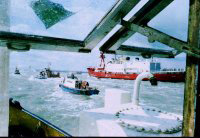
|
When
T.I.D. 164 was taking part in the welcome home of Endurance, after
the Falklands War, the Royal Navy was about to leave Chatham Dockyard.
Hearing of the plight of the John H. Amos in Faversham the Royal
Navy allocated two buoys for the use of Medway Maritime Museum.
They were to await the formation of the Chatham Historic Dockyard
Trust |
|
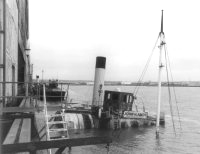
|
When
the Trust was formed the two steam tugs were moved to Anchor
Wharf in the Historic Dockyard. This was just down river from
the original berth at Gun Wharf and with the addition of twenty
tons of chalk was a good berth.
When the Historic Dockyard Trust acquired the submarine Ocelot,
which was built there in Number Seven Slip, they required the
John H. Amos to move from her prepared berth. On the new berth
she sat on a lump of concrete and sank.
|
|
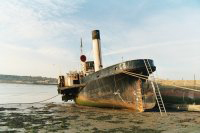
|
English
Partnership, who were developing the neighbouring part of the
dockyard, were asked for help and the two tugs were allowed
to occupy a disused slipway, free of charge, with the opportunity
to do repairs to the hull of the John H. Amos.
In
November 1999 the National Historic Ships Committee included
the John H. Amos in their "Core Collection" as a vessel of "Pre-eminent
National Significance" and among the most worthy vessels for
preservation.
|
|
|
2001
to 2006
In 2001 the ownership of the John H. Amos was transferred to
a Charitable Trust, the Medway Maritime Trust. The
first funding came from the PRISM Fund at the Science Museum
and Martin Stevens on the transfer of ownership.
Further
grant aid has since been received from The Heritage Lottery
Fund (project planning grant), National Historic Ships and Rochester
Bridge Trust. G.P.S. Marine have helped in kind.
|
|
|
Among
the first Trustees of the Medway Maritime Trust were Martin
Stevens and Dr Robert Prescott.
Martin
Stevens, Chairman of theTrust, is the proprietor of a family
business in Kent selling woodstoves and gardening machinery.
He ran the last fleet of working steam tugs in the UK and has
been instrumental in the saving of several vessels, including
the steam tug TID 164, steam coaster VIC 96 and more recently
the 1902 Customs Cruiser VIGILANT.
|
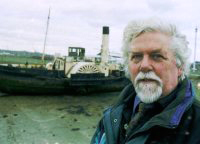 |
Dr.
Robert Prescott, formerly Project Director of the National Historic
Ships Committee, head of the Scottish Institute of Maritime
Studies at St. Andrews University, and holder of a Caird Senior
Fellowship at The National Maritime Museum at Greenwich.
He
is now Chairman of the Advisory Committee of National
Historic Ships, reporting to the Secretary of State at the
Department of Culture Media and Sport.
|
| |
|
|
|
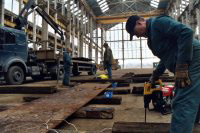 |
The
John H Amos was due to be slipped in early April 2004. This
was to be done in No.7 slip at Chatham Historic Dockyard.
However,
due to a delay concerning the lawyers of the Chatham Historic
Dockyard Trust and those of Turk's Shipyard, (the proposed tenant),
the date for slipping came and went. This turned out to be a
very expensive episode for the Medway Maritime Trust as contractors
had to be paid cancellation fees.
|
|
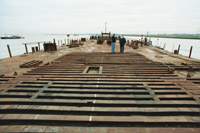
|
2006
- 2008
The
Pontoon PORTAL NARVIK and the floating crane ATLAS
The Medway Maritime Trust had acquired the services of a giant
pontoon named Portal Narvik. Its dimensions are 60 x 16 metres,
(200 x 50 feet). That's nearly a quarter of an acre!
After the diversion of the Number Seven Slip episode the pontoon
idea had to be resurrected, and by chance Martin was telephoned
by Kier Plant who said they had had a change of management.
It evolved that the man who originally showed him round the
pontoon and was very supportive towards the John H Amos project,
had become the new Managing Director. He made an offer which
could not be refused and the pontoon had new owners.
|
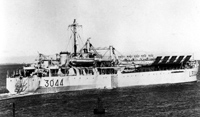 |
The
pontoon Portal Narvik is an historic ship in her own right.
She is all that is left of HMS Narvik, a Tank Landing Ship,
launched on the 29th July 1945 as LST 3044. She was powered
by a triple expansion steam engine.
She
was the flagship of the British Task Force for the atomic bomb
tests in the Monte Bello Islands in 1956 and again served as
the mother ship for Dr. Penny's team at the Christmas Island
hydrogen bomb tests. She later served as a depot ship in Malta.
Records say that she was scrapped in 1965.............. Not
quite.
The
Trust is saving up for a Geiger counter!
(Click
here for
an article about HMS Narvik from 'Old Glory' magazine, March
2007).
|
|
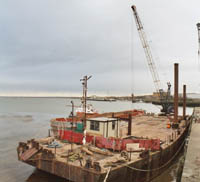
|
Until
Christmas 2004 the pontoon had a crane mounted on it and was earning
money for the Trust on a contract at the Isle of Grain in Kent
erecting a jetty. The money was to help pay for lifting the John
H Amos onto the pontoon. |
|
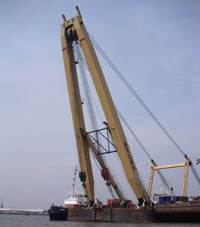
|
The
crane which was to be used for the lift is one of the largest
in Europe, the GPS Atlas, formerly Smit Tak's Taklift 3. |
|
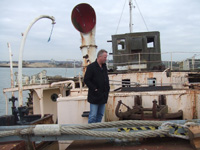
|
Jaco Sluijmers, director of operations with the specialist Dutch
team who operate the Atlas, visited the John H Amos twice to plan
the lift. |
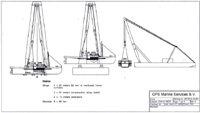 |
Meanwhile
final preparations were underway on the John H Amos and Portal
Narvik.
That's
the story so far. For
up-to-date news go to THE
BIG LIFT
|